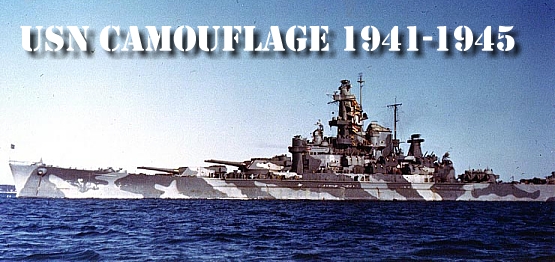
An online database of camouflage used by
United State Naval Warships during WWII
|
|
The
Development of Naval Camouflage 1914 – 1945
|
TYPE |
PENDANT
NUMBER COLOR |
|
Scheme
A. |
White
or black. |
|
Scheme
B. |
B15 |
|
Scheme
C & D |
B30 |
|
Scheme
G |
Red |
|
Scheme
H & J |
G45 |
Color listed on the left is
tone of paint on vertical surface.
Color on the right corresponds
to tone of paint on adjacent horizontal surface. See camouflage tables for use
when appropriate.
|
White |
G45 |
|
B55 |
B30 |
|
G45 |
G20 |
|
B30 |
B15 |
|
G20 |
G10 |
|
B15 |
G10 |
|
B20 |
G10 |
|
G10 |
G5 |
|
G5 |
Black |
|
White |
507C |
|
W/A Blue |
B6 |
|
507C |
MS 3 |
|
B6 |
B5 |
|
B5 |
MS 2 |
|
MS 2 |
MS 1 |
|
MS 1 |
Black |
DECK COVERINGS (BRITISH)
The colors given are those used
in peacetime practice and were used with the appropriate camouflage type - see
list of camouflage types.
SEMTEX: A trowelled-on non-slip
composite material.
Used on destroyers from the
Tribal Class (1938) onwards. Used sometimes on small working areas of wartime
construction cruisers and battleships and refitted cruisers and battleships.
Used on war built escort vessels.
Color: Medium dark green.
CORTICENE: A linoleum, held
down by thin brass strips. Used on most new construction from around 1915
onwards, on ships of destroyer size downwards. Last destroyer class to use
Corticene was the ”I” class of the late thirties. Used on small working
areas of large ships up to the late thirties.
Color: Medium brown - described as the color of milk chocolate.
ASPHALT: A trowelled-on
material.
Used primarily on WW II built escort vessels beginning
with the River class frigates, and on older destroyers as they converted to the
escort role or were refitted and repaired.
Color: Medium dark grey/grey
black.
WOOD PLANKING
Used on battleships, cruisers,
and interwar built sloops. Areas of planking substantially reduced in wartime
refits except for battle- ships. Wood planking was not used on carrier decks.
Not used on destroyers or escorts.
Color: Varied, depending on
type of wood, exposure to elements, and frequency of cleaning, When newly laid
the color was of a medium tone.